Harness your curiosity and discover if bees are captivated by the scent and sight of sage in gardens!
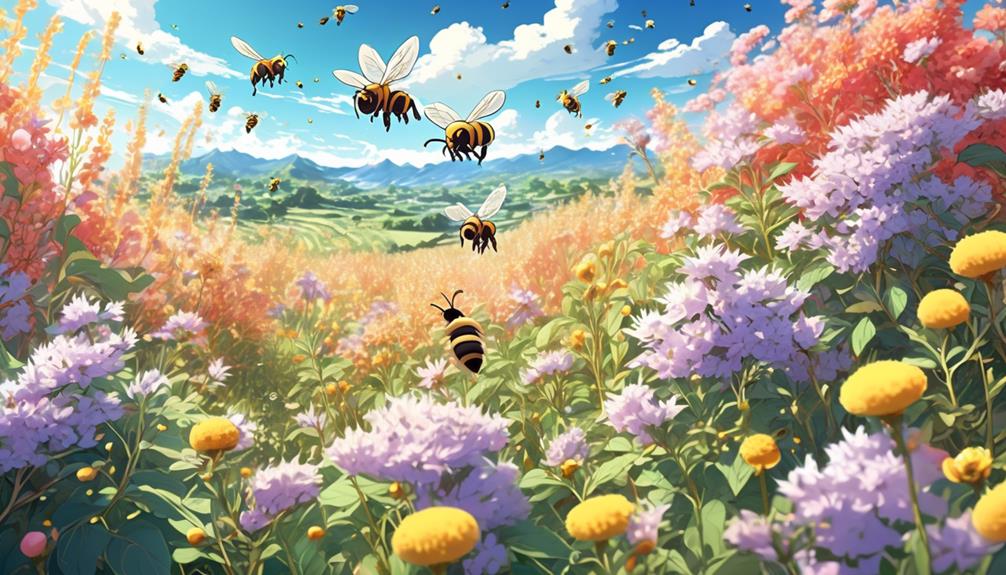
Do Bees Like Sage?
Bustling bees busily buzzing around blooming flowers is a common sight, but have you ever wondered if they exhibit preferences? Specifically, are they drawn to the aromatic allure of sage?
Sage, both culinary and ornamental, is a popular plant in many gardens, but whether it's equally popular with our pollinating pals is a question worth exploring.
So strap yourself in, as we're about to embark on an intriguing investigation into the relationships between bees and sage.
Key Takeaways
- Bees are attracted to sage for its vibrant hues, scent, shape, and nectar production.
- Sage's nectar-rich flowers and ultraviolet patterns act as a powerful draw for bees, providing a high-energy food source.
- The structure of sage flowers allows easy access to nectar, enhancing bee visitation and promoting effective pollination.
- Attracting bees with sage enhances pollination rates, increases biodiversity, and contributes to the sustainability of the ecosystem and food sources.
Understanding Bee Attraction to Flowers
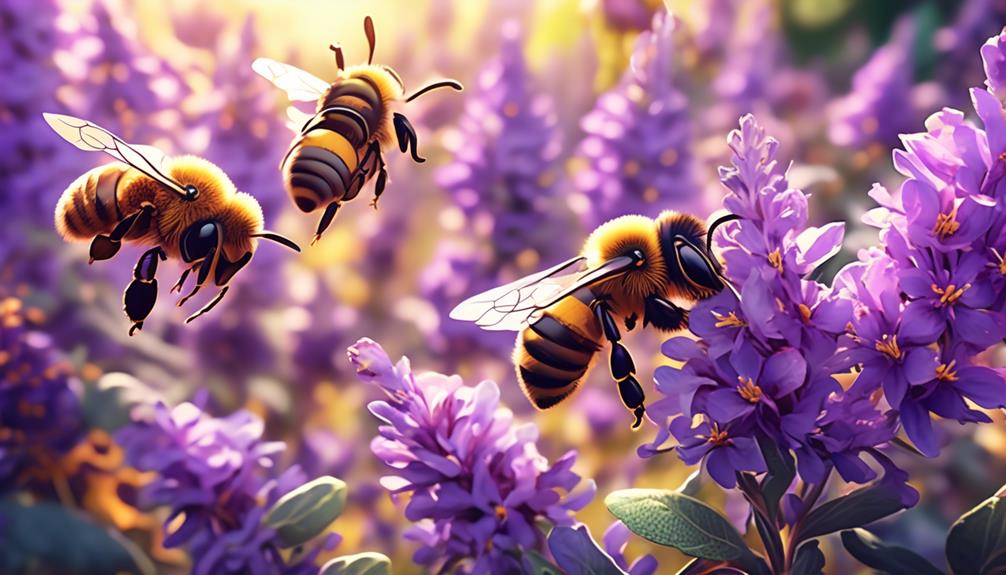
To fully grasp why bees are drawn to certain flowers like sage, you need to delve into the intricate dance of attraction that happens between these buzzing pollinators and their floral partners. Flowers, including sage, have specific characteristics that attract bees. It's not just about the vibrant hues, but also the scent, shape, and nectar production.
When you look at sage, for instance, you'll notice it's not just pretty to look at, but it also exudes a powerful scent. Bees have an exceptional sense of smell, which allows them to detect these fragrances from miles away. The scent of sage, combined with its beautiful blue or purple color, acts as a beacon for bees.
Moreover, the shape of the sage flower is convenient for bees. It's tubular, allowing bees easy access to its nectar. Don't forget, nectar is a bee's primary source of energy; it's basically their fuel. So, plants producing abundant nectar, like sage, are irresistible to bees.
In essence, bees are attracted to sage not only for its aesthetic appeal but also for its rich nectar supply and inviting scent.
Sage: A Brief Overview
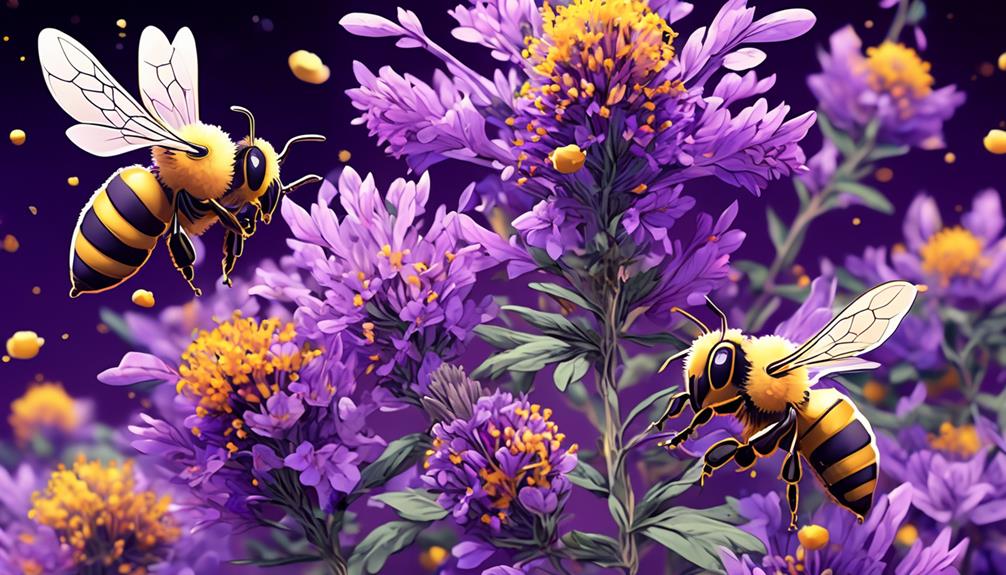
Let's delve into the world of sage, a versatile herb lauded not only for its culinary uses but also for its beauty and the allure it holds for our little pollinator friends, the bees.
Native to the Mediterranean region, sage, or Salvia officinalis, belongs to the mint family and is known for its aromatic properties and distinctive flavor.
You'll often find sage used in various cuisines worldwide, specifically in dishes such as stuffing, sauces, and sausages. It's a fantastic companion to fatty meats, thanks to its robust flavor that can cut through the richness.
But, it's not just a culinary superstar. It's also a striking ornamental plant, boasting grey-green foliage and beautiful purple, pink, or white flowers that bloom from late spring to early summer.
What's more, sage is a magnet for bees. Its vibrant flowers full of nectar and pollen are irresistible to these vital pollinators. Bees are particularly attracted to the ultraviolet patterns on sage flowers, which act like landing strips guiding them to the nectar.
Sage's Appeal to Bees
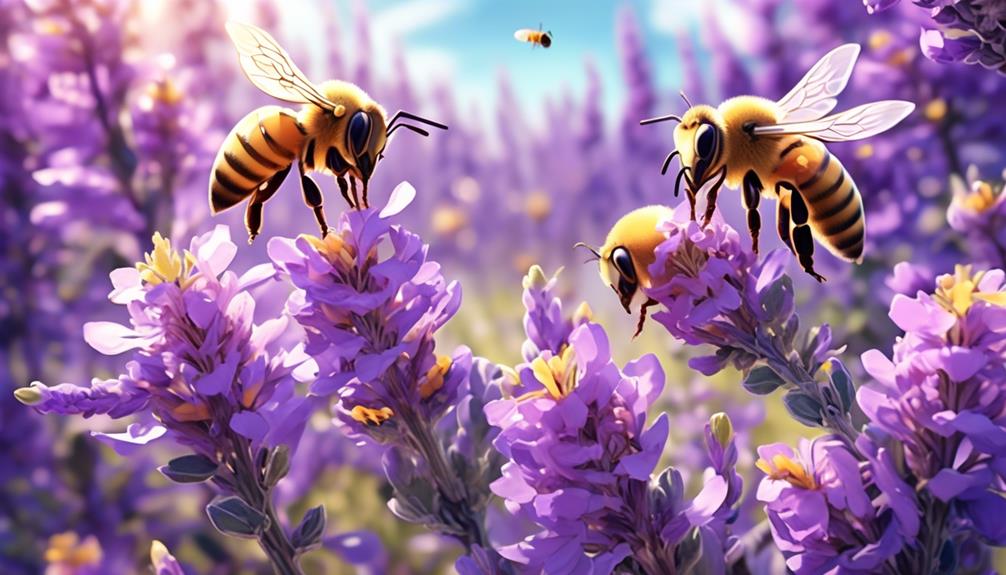
Diving into the allure sage holds for bees, you'll find that this herb's nectar-rich flowers and distinctive ultraviolet patterns act as a powerful draw for these vital pollinators. The nectar serves as a high-energy food source, fuelling the bees' busy lifestyle. Meanwhile, the ultraviolet patterns, invisible to the human eye but glaringly obvious to bees, guide them directly to the nectar, enhancing their efficiency.
But the appeal doesn't stop there. Sage's long blooming season, from spring through to autumn, provides a consistent food source when other plants might be lacking. This makes it a valuable asset in a bee's environment, contributing to their survival and propagation.
Additionally, the structure of sage flowers is a perfect fit for bees, facilitating the transfer of pollen. Each blossom has two stamens that deposit pollen onto the bee as it reaches for the nectar, thereby effectively ensuring pollination.
Scientific Evidence: Bees and Sage
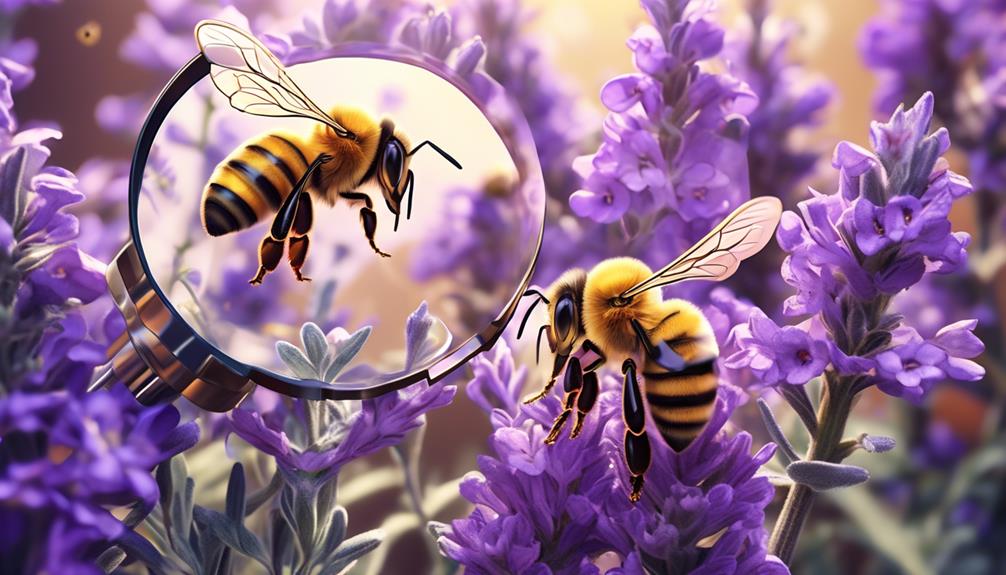
Numerous scientific studies provide compelling evidence that bees are indeed attracted to sage, substantiating the observations of gardeners and beekeepers around the world. Researchers have found that the nectar of sage plants contains a high sugar concentration, which is a primary attractant for bees. The blue or purple flowers of the sage, preferred by bees, also play a significant role in this attraction.
But it's not just about the color and sweetness. Scientists have discovered that the scent of sage is equally enticing to bees. Sage emits a strong aroma that bees can detect from a distance, guiding them to a potential nectar source. Plus, the structure of sage flowers facilitates easier access to nectar, thus promoting bee visitation.
Moreover, studies show that sage plants bloom for a long period, providing a consistent food source for bees. This factor, combined with the plant's drought tolerance, makes sage a reliable, year-round attraction for bees.
In short, scientific evidence backs up what you might've suspected: bees do like sage. It's the combination of color, scent, nectar accessibility, and blooming duration that makes sage an irresistible magnet for these important pollinators.
Benefits of Attracting Bees With Sage

Attracting bees with sage offers significant environmental and horticultural benefits that are worth understanding. As an integral part of our ecosystem, bees play a crucial role in pollination. Sage, with its appealing scent and prolific flowers, can serve as an ideal plant to draw in these valuable insects.
Benefits of Attracting Bees | Role of Sage |
|---|---|
Enhanced Pollination | Sage's abundant flowers attract a high number of bees, boosting pollination rates. |
Increased Biodiversity | The presence of sage can help support a diverse bee population, enriching the local ecosystem. |
Improved Garden Yield | Sage can increase bee visits to your garden, leading to improved fruit and vegetable yields. |
Environmental Sustainability | By attracting bees, sage contributes to the sustainability of our environment and food sources. |
Encouraging Bees: Growing Sage in Your Garden
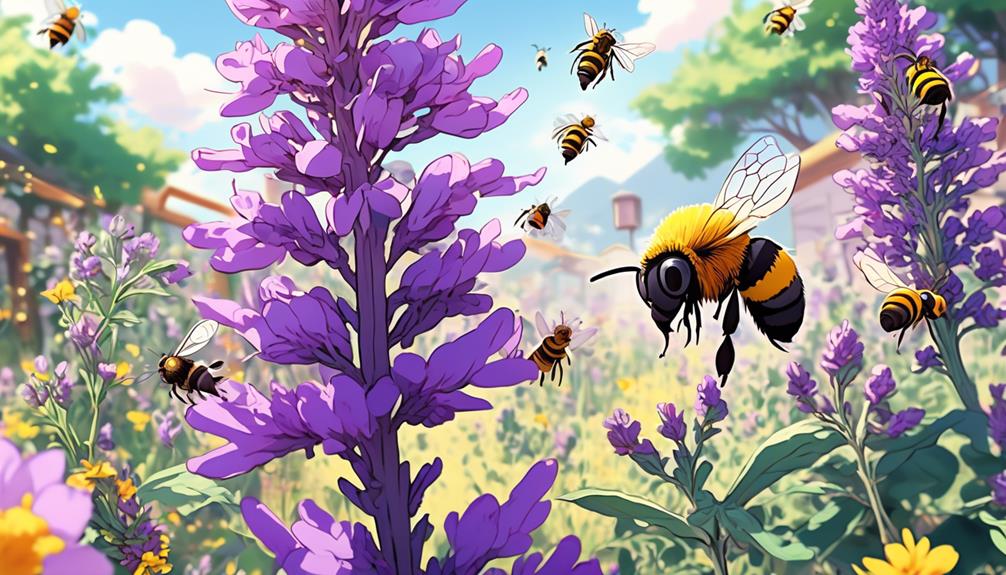
If you're looking to give bees a helping hand and enrich your garden, planting sage can be a smart move. Sage, or Salvia officinalis, is a versatile plant that's not only beloved by bees but also easy to grow. It thrives in full sun, well-drained soil, and prefers a pH between 6.0 and 7.0. It's drought tolerant, making it a low-maintenance choice for your garden.
To encourage bees, consider planting multiple sage plants together. The large, vibrant blooms will attract bees, providing them with plenty of nectar. This grouping also creates a more substantial visual and aromatic lure for the bees.
Remember, while sage is a perennial plant, it often becomes woody and less attractive to bees after 3-5 years. Therefore, it's a good idea to replant it every few years to ensure a consistent supply of nectar.
Growing sage isn't just about attracting bees, though. The leaves can be used in cooking, and the plant is known for its medicinal properties. By planting sage, you're not only helping the bees but also enriching your garden and potentially your kitchen, too.
Frequently Asked Questions
What Other Herbs or Plants Also Attract Bees Similar to Sage?
You're asking about other plants that attract bees, just like sage does. Well, there's a wide variety you can plant in your garden.
Lavender, borage, and thyme are all fantastic choices. Bees also love mint and rosemary. Marjoram and hyssop are two other herbs that bees find irresistible.
Don't forget about flowers like sunflowers, coneflowers, and poppies.
Are There Specific Species of Bees That Are More Attracted to Sage Than Others?
Yes, indeed, certain bee species show a stronger attraction to sage. Honey bees and bumble bees are particularly drawn to this plant. They're enticed by the blue and violet hues of sage blooms and the plant's high nectar production.
Can Sage Be Used to Attract Bees for Purposes Other Than Gardening, Such as Beekeeping?
Absolutely, you can use sage to attract bees for beekeeping. Bees can't resist the intoxicating aroma of sage and its high nectar content.
It's not just beneficial for garden aesthetics, but it's also a fantastic choice if you're aiming to increase your hive's population. Just remember, it's essential to provide a variety of flowers to ensure your bees get a balanced diet.
Are There Any Negative Effects for Bees When They Are Attracted to Sage?
You're wondering if there are any negative effects for bees when they're attracted to sage.
To my knowledge, there aren't any harmful results. On the contrary, sage provides a good source of nectar and pollen for bees.
It's a win-win situation: bees get their food, and the sage gets pollinated.
However, it's important to ensure that the sage hasn't been treated with pesticides, as this could be detrimental to the bees.
What Is the Best Time of Year to Plant Sage to Attract Bees?
You're wondering when to plant sage for attracting bees. It's best to plant sage in the spring. This gives the plant ample time to establish itself before winter.
By the following summer, it'll be ready to flower. Bees are attracted to these blooms and will visit them for nectar and pollen.
Planting in spring ensures a strong, healthy plant that can provide a food source for bees when many other plants aren't flowering.
Conclusion
So, do bees like sage?
Absolutely! Science and observation confirm their attraction to this aromatic herb. Sage's appealing scent, vibrant color and rich nectar make it a bee magnet.
Growing sage in your garden not only benefits these vital pollinators but also adds beauty and variety to your green space.
So go ahead, plant some sage, and watch these industrious workers buzz in appreciation.



